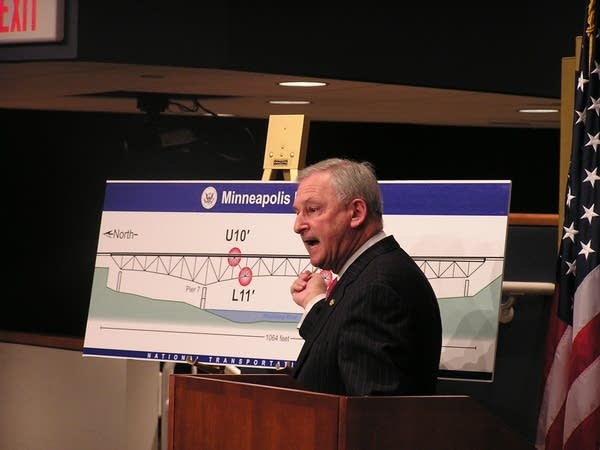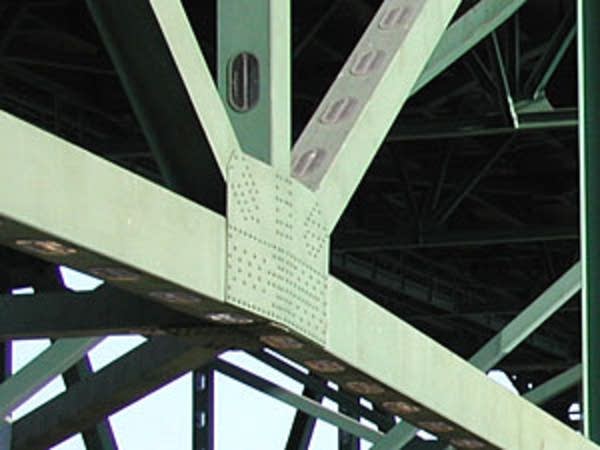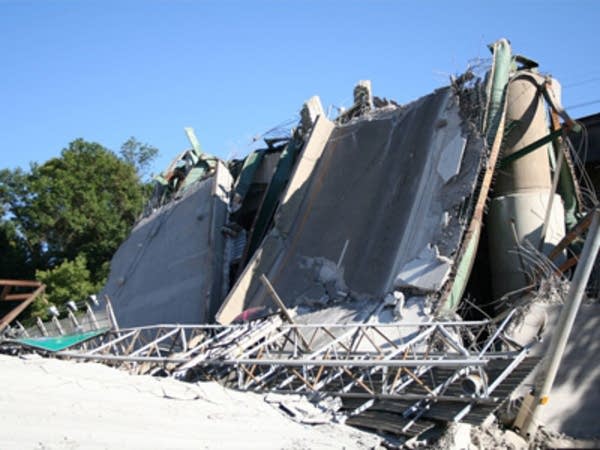NTSB investigators surprised by what they found
Go Deeper.
Create an account or log in to save stories.
Like this?
Thanks for liking this story! We have added it to a list of your favorite stories.

NTSB Board chairman Mark Rosenker said the board does not know "which straw broke the camel's back." However, the board does know that the collapse started at the southern end of the bridge. Construction material for a new bridge deck sat on that end of the bridge.
This tells us why the bridge collapsed.
Rosenker says more than two dozen gusset plates at the southern end of the span were the problem. Two gusset plates hold together each steel joint, or node, on the bridge. Rosenker says eight joints were particularly weak at the time of the collapse.
"All 16 gusset plates from those eight nodes were fractured. The other gusset plates from the main trusses were intact. Gusset plates are generally designed to be stronger than beams they connect, and one would not expect to find them fractured," said Rosenker.
This discovery prompted the NTSB to look at the bridge construction materials, the concrete and steel. But none of it was deficient. The problem, Rosenker said, was with the original design of the bridge.
Turn Up Your Support
MPR News helps you turn down the noise and build shared understanding. Turn up your support for this public resource and keep trusted journalism accessible to all.
"The investigation has determined the design process led to a serious error in sizing some of the gusset plates in the main trusses. Specifically, the gusset plates at the eight nodes I mentioned to you earlier. Basically, those gusset plates were too thin to provide the proper amount of safety in a bridge of this scale," explained Rosenker.

Rosenker says this discovery came as a shock to investigators. No other bridge disaster has ever had this type of flaw.
According to Roseker, investigators searched for the calculations of the design, but none were found. The firm that designed the bridge is no longer in business.
Steel truss bridges are more likely to be "fracture critical," that is, they are more likely to fail than other bridge structures, such as a suspension bridge. It's a fact of their design.
Think of it like a series of links in a chain. The steel truss bridge doesn't have any structural redundancy that might support a weak link in the chain. If one thing breaks, the whole structure falls, and that's what happened on August 1, 2007, during the evening rush hour.

Rosenker, in pointing out flaws in the original design of the 35W bridge, seemed to exonerate any problems with maintenance or inspections.
Before a bridge is built, computations are done to ensure the length, width and thickness specifications are all accurate. In this instance, these particular gusset plates were designed too thin. They should have been one inch thick, but those plates were only 1/2 inch thick. In 1967, when the bridge was built, no one caught the flaw.
"It is important to understand that the bridge inspections would not have identified the error in the design of the gusset plates," said Rosenker.

Rosenker says inspections look at wear and tear, not whether the bridge was designed safely.
However, MnDOT did look into the bridge's design twice in its lifetime, in 1977 and 1998, when the bridge underwent expansions. Lanes were added, the thickness of roadway concrete went from six and a half inches to eight and a half inches, and the medians were heightened.

Those changes added a significant amount of weight to the bridge. But because the department didn't know the gusset plates were too thin, inspectors didn't check whether the plates could bear the added weight.
Across the country, there are 465 other bridges like the 35W. Minnesota has 23 trunk highway bridges that are similar in design to the I-35W bridge.
Rosenker says he believes this design flaw is specific to the I-35W bridge.
"However, if you are going to make changes in loads or in additional loads of traffic, higher loads of traffic, then it is prudent to recalcuate not just your gusset plates, but the entire composition of the elements of your bridge," said Rosenker.
Many of the gusset plates on the 35W bridge were corroded, but according to Rosenker, corrosion did not play a part in the collapse of the bridge.
Engineering consultants for MnDOT did recommend that the department reinforce the bridge's gusset plates. The plates had rusted away to half their original thickness, already undersized for the bridge's weight.
Rosenker won't say whether reinforcing those gusset plates would have prevented the collapse of the bridge.
"I'm not going to speculate, if it were designed properly, it could. if it were not designed properly, it might not," said Rosenker.
He did say that investigators will spend the next six months looking into what caused the bridge and its weak gusset plates to fail. Rosenker says the added weight from construction materials on the bridge may have been a factor.
He says the final report on the bridge collapse will be completed by the fall of 2008.



